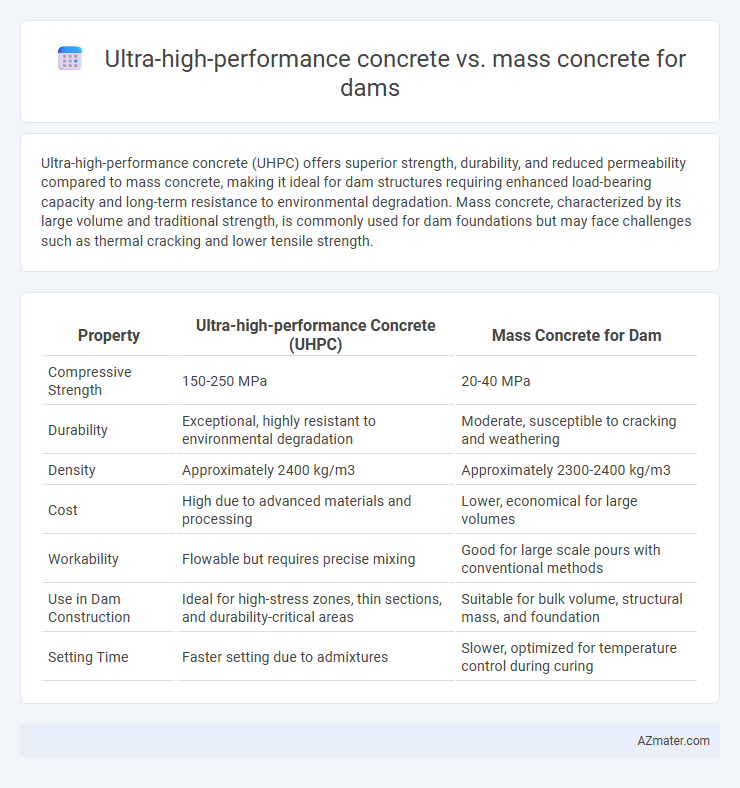Ultra-high-performance concrete (UHPC) offers superior strength, durability, and reduced permeability compared to mass concrete, making it ideal for dam structures requiring enhanced load-bearing capacity and long-term resistance to environmental degradation. Mass concrete, characterized by its large volume and traditional strength, is commonly used for dam foundations but may face challenges such as thermal cracking and lower tensile strength.
Table of Comparison
| Property | Ultra-high-performance Concrete (UHPC) | Mass Concrete for Dam |
|---|---|---|
| Compressive Strength | 150-250 MPa | 20-40 MPa |
| Durability | Exceptional, highly resistant to environmental degradation | Moderate, susceptible to cracking and weathering |
| Density | Approximately 2400 kg/m3 | Approximately 2300-2400 kg/m3 |
| Cost | High due to advanced materials and processing | Lower, economical for large volumes |
| Workability | Flowable but requires precise mixing | Good for large scale pours with conventional methods |
| Use in Dam Construction | Ideal for high-stress zones, thin sections, and durability-critical areas | Suitable for bulk volume, structural mass, and foundation |
| Setting Time | Faster setting due to admixtures | Slower, optimized for temperature control during curing |
Introduction to Dam Construction Materials
Ultra-high-performance concrete (UHPC) offers exceptional strength, durability, and reduced permeability compared to traditional mass concrete, making it ideal for critical dam sections requiring enhanced performance. Mass concrete, characterized by its large volume and slower curing process, is commonly used for dam foundations and bulk structures due to its cost-effectiveness and thermal stability. The selection between UHPC and mass concrete depends on structural demands, environmental conditions, and longevity requirements in dam construction materials.
Defining Ultra-High-Performance Concrete (UHPC)
Ultra-high-performance concrete (UHPC) is a highly durable material characterized by a compressive strength exceeding 150 MPa and enhanced tensile properties due to fiber reinforcement. Unlike traditional mass concrete used in dams, which relies on sheer volume to achieve strength, UHPC offers superior durability, reduced permeability, and improved corrosion resistance, making it ideal for critical dam components. Its compact microstructure and enhanced mechanical properties contribute to longer service life and lower maintenance costs in dam engineering.
Characteristics of Mass Concrete
Mass concrete for dams is characterized by its large volume and low heat of hydration, which helps control temperature rise and reduces thermal cracking risks during curing. It typically has lower strength and durability compared to ultra-high-performance concrete but offers cost-effectiveness and ease of placement in massive structures. Its thermal conductivity and specific heat capacity are critical for managing internal temperature gradients in substantial concrete pours.
Mechanical Strength Comparison
Ultra-high-performance concrete (UHPC) exhibits significantly higher mechanical strength compared to conventional mass concrete used in dam construction, with compressive strengths often exceeding 150 MPa, while typical mass concrete ranges between 20 to 40 MPa. UHPC's dense microstructure and advanced fiber reinforcement contribute to superior tensile strength, durability, and resistance to cracking under high stress conditions. The enhanced mechanical properties of UHPC allow for slimmer structures and extended service life, reducing maintenance costs and improving dam safety.
Durability and Longevity Factors
Ultra-high-performance concrete (UHPC) offers superior durability and longevity compared to mass concrete in dam construction due to its exceptionally low permeability and high compressive strength, which significantly reduce the risk of cracking and chemical attack. UHPC's dense microstructure enhances resistance to freeze-thaw cycles, sulfate attack, and alkali-silica reaction, critical factors in extending the service life of dams. The improved durability characteristics of UHPC minimize maintenance needs and extend the operational lifespan of dams, making it a cost-effective and resilient alternative to traditional mass concrete.
Thermal Behavior in Dam Applications
Ultra-high-performance concrete (UHPC) exhibits significantly lower thermal conductivity and reduced heat of hydration compared to mass concrete, minimizing thermal gradients and associated cracking risks in dam construction. The enhanced thermal stability of UHPC allows for more efficient heat dissipation, reducing cooling requirements and improving structural durability under thermal stress. In contrast, mass concrete often requires extensive cooling measures to control temperature differentials, making UHPC a preferable choice for optimizing thermal behavior in dam applications.
Construction Techniques and Challenges
Ultra-high-performance concrete (UHPC) offers superior durability and strength compared to traditional mass concrete, enabling thinner dam structures with enhanced seismic resistance and reduced permeability. Construction techniques for UHPC demand precise mixing, placement, and curing processes to optimize fiber dispersion and hydration, whereas mass concrete requires careful temperature control to prevent thermal cracking during curing. Challenges with UHPC include higher material costs and the need for specialized equipment, while mass concrete presents difficulties in managing heat of hydration and ensuring uniform compaction over extensive volumes.
Cost-Benefit Analysis
Ultra-high-performance concrete (UHPC) offers superior durability, reduced permeability, and higher compressive strength compared to mass concrete, leading to extended dam lifespan and lower maintenance costs. Although initial UHPC material costs are higher, the reduced volume required and accelerated construction timelines significantly offset these expenses. Cost-benefit analysis reveals that UHPC's long-term savings on repairs and enhanced structural performance provide greater economic value for dam projects than traditional mass concrete.
Environmental Impact Assessment
Ultra-high-performance concrete (UHPC) significantly reduces environmental impact in dam construction by requiring less material volume due to its higher strength and durability compared to mass concrete. The lower cement content and enhanced longevity of UHPC decrease CO2 emissions and reduce maintenance frequency, leading to a smaller carbon footprint over the dam's lifecycle. Mass concrete, characterized by higher cement consumption and thermal cracking risks, often results in increased greenhouse gas emissions and potential environmental degradation during construction.
Suitability of UHPC vs Mass Concrete for Dams
Ultra-high-performance concrete (UHPC) offers superior compressive strength, durability, and reduced permeability compared to mass concrete, making it highly suitable for dam construction where structural integrity and longevity are critical. Unlike mass concrete, which often requires extensive curing and temperature control to prevent cracking, UHPC's dense microstructure minimizes thermal gradients and shrinkage issues in large-scale dam applications. The enhanced mechanical properties and chemical resistance of UHPC provide improved resilience against environmental stressors, positioning it as a preferable material for modern dam engineering.

Infographic: Ultra-high-performance concrete vs Mass concrete for Dam
 azmater.com
azmater.com